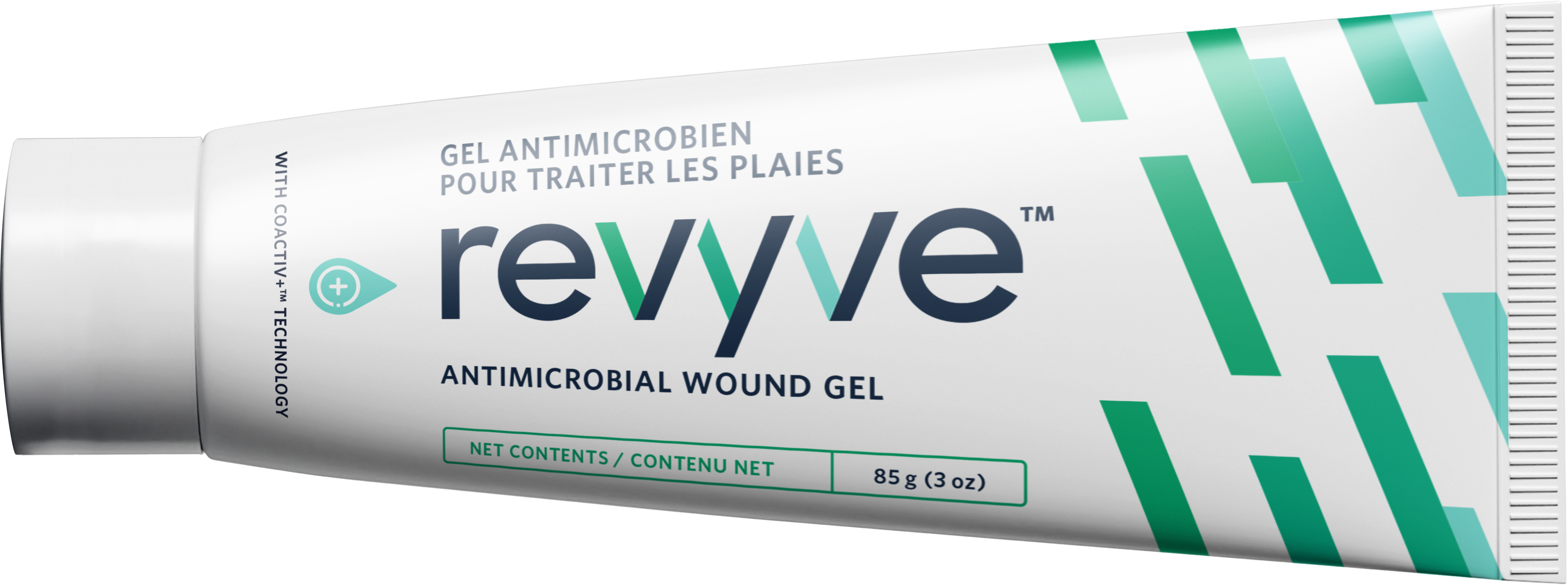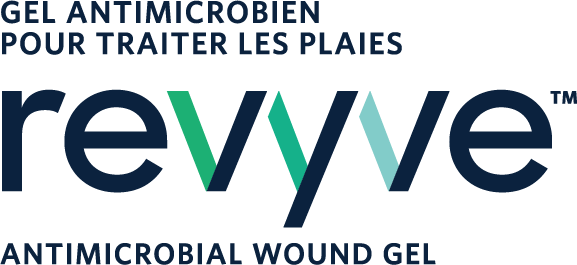
Changer le paradigme des soins de plaie

La formulation unique à triple action
Le gel antimicrobien pour traiter les plaies revyve🅪 s'inscrit dans l’approche DIME en agissant sur les trois premières étapes du processus de cicatrisation® .

revyve® Antimicrobial Wound Gel is indicated for the use on:
- Plaies superficielles et profondes
- Ulcères de jambe
- Plaies à grande surface
- Plaies de pression
- Plaies chirurgicales
- Brûlures au 1er et 2e degré
- Ulcères du pied diabétique
”« Je l’ai essayé sur un patient en CHSLD qui éprouvait une grande douleur en raison d’une plaie de pression de stade 4 avec un exsudat important. La réaction a été remarquable grâce à la réduction de l’exsudat et de la douleur après seulement quelques changements de pansement ».
Dre Noland, équipe du Lakeview Family Health, Colborne, (Ontario) Canada*
Nouvelle application par vaporisation sans aérosol
- Traitement sans contact, pouvant être appliqué rapidement sur les plaies traumatiques, de grande surface et difficiles d’accès
- Un vaporisateur de gel épais qui adhère parfaitement et reste en place sur la plaie
- Conçu pour une application et un retrait indolore du gel
- Brevet en instance
Le vaporisateur de gel est actuellement en cours d’examen par Santé Canada
La mauvaise guérison liée au biofilm est le plus grand défi non résolu en soin des plaies
Plus de 70 % des brûlures et 80 % des plaies chroniques présentent une couche de biofilm. Les données récentes suggèrent que toutes les plaies chroniques contiennent du biofilm sur au moins une partie du lit de la plaie.
La formation de biofilm peut rendre les bactéries jusqu’à 1 000 fois plus résistantes aux antibiotiques, aux agents antimicrobiens, aux désinfectants et au système immunitaire de l’hôte. Les biofilms sont également l’un des principaux facteurs contribuant à la résistance aux antibiotiques. Le NIH (National Institutes of Health) estime que 80 % de toutes les infections humaines connues sont associées aux biofilms.
revyve® Antimicrobial Wound Gel is effective against:
LES BACTÉRIES GRAM-NEGATIVES
Escherichia coli | E. coli
Acinetobacter baumannii
Klebsiella pneumoniae
Pseudomonas aeruginosa
BACTÉRIES GRAM-POSITIVES
Staphylocoque doré
Staphylocoque doré résistant à la méthicilline (SARM)
Entérocoque fécal
Streptococcus pyogenes
Cutibacterium acnes
CHAMPIGNONS
Candida albicans
À propos de Kane Biotech
Kane Biotech is a biotechnology company engaged in the research, development and commercialization of technologies and products that prevent and remove microbial biofilms.
(1) S. ASATI, U. CHAUDHARY, Prevalence of biofilm producing aerobic bacterial isolates in burn wound infections at a tertiary care hospital in northern India, Ann Burns Fire Disasters, 31 mars 2017; 30 (1): 39 à 42. (2) M. MALONE, T. BJARNSHOLT, A. J. MCBAIN, G.A. JAMES, P. STOODLEY, D. LEAPER, M. TACHI, G. SCHULTZ, T. SWANSON, R.D. WOLCOTT, The prevalence of biofilms in chronic wounds: a systematic review and meta-analysis of published data, Journal of Wound Care, 2 janv. 2017; 26 (1): 20–5. (3) A.G. GOSWAMI, S. BASU, T. BANERJEE, et coll., Biofilm and wound healing: from bench to bedside, European Journal of Medical Research, 2023 28, 157. (4) S.M. MCCARTY, S.L. PERCIVAL, Proteases and Delayed Wound Healing, Advances in Wound Care (New Rochelle), octobre 2013; 2 (8): 438 à 447. (5) S. FINNEGAN, S.L. PERCIVAL, EDTA: An Antimicrobial and Antibiofilm Agent for Use in Wound Care, Adv Wound Care (New Rochelle), juillet 2015 1; 4 (7): 415 à 21. (6) GAWANDE, K. LOVETRI, N. YAKANDAWALA, G. FROELICH, S. MADHYASTHA, Antimicrobial-antibiofilm compositions and methods of use thereof [tiré de l’Internet], Winnipeg, Man.; US9980497B2, 2018, tiré de: https://patents.google.com/patent/US9980497B2 (7) J. VISVALINGAM, N. YAKANDAWALA, S. REGMI, SP LEE, Sailer approach to biofilm and metalloprotease problem in chronic Wounds, lors du Symposium sur le soin des plaies de pointe, National Habor, BD, É.-U. ; 2023. (8) A. RODGERS, L. WATRET, The role of pH modulation in wound bed preparation, The Diabetic Foot, 2005; 8(3): 154-7. (9) J. VISVALINGAM, S. REGMI, S.P. LEE., M. EDWARDS, R. ABDO, G. SCHULTZ, A thermo-reversible hydrogel against chronic, burn and combat wound associated pathogens, lors du Symposium sur le soin des plaies de pointe, Orlando, Floride, É.-U.; 2024. (10) M. SAILER, J. VISVALINGAM, S. REGMI, A. MUZALEVA, G. SCHULTZ, A novel thermo-reversible antimicrobial hydrogel spray with effective antibiofilm properties to treat complex combat wounds, MHSRS, Kissimmee, Floride, É.-U.; 2024. (11) N.O. HÜBNER, A. KRAMER, Review on the Efficacy, Safety and Clinical Applications of Polihexanide, a Modern Wound Antiseptic, Skin Pharmacol Physiol, 2010; 23 (suppl. 1), 17 à 27. (12) D. GRAY, S. BARRETT, M. BATTACHARYYA, M. BUTCHER, S. ENOCH, S. FUMEROLA, et coll., PHMB and its potential contribution to wound management, Wounds RU, 2010; 6(2): 40-6. (13) M.G. RIPPON, A.A. ROGERS, K. OUSEY, Polyhexamethylene biguanide and its antimicrobial role in wound healing: a narrative review, J Wound Care, 2 janv. 2023; 32 (1) : 5–20. (14) S.L. PERCIVAL, R. CHEN, D. MAYER, A. SALISBURY, Mode of action of poloxamer‐based surfactants in wound care and efficacy on biofilms, Int Wound J., juin 2018, 5; 15 (5): 749–55. (15) S.L. PERCIVAL, D. MAYER, R.S. KIRSNER, G. SVHULTZ, D. WEIR, S. ROY, et coll., Surfactants: Role in biofilm management and cellular behaviour, International Wound Journal, juin 2019; 16 (3): 753-60. (16) J. VISVALINGAM, N. YAKANDAWALA, S. REGMI, P. SHARMA, M. SAILER, Anti-biofilm and anti- metalloprotease activity of a novel wound gel, lors du Symposium sur le soin des plaies de pointe de l’automne, Las Vegas, Nevada, É.-U.; 2022. (17) J. VISVALINGAM, M. SAILER, M. EDWARDS, G. SCHULTZ, A Novel Thermo-Reversible Antimicrobial Hydrogel Spray to Treat Complex Combat Wounds, lors du MTEC Annual Meeting, Baltimore, Maryland, É.-U.; 2024. (18) J. VISVALINGAM, N. YAKANDAWALA, S. REGMI, A. ADENIJI, P. SHARMA, M. SAILER, M., Wound Gel Formulations Containing Poloxamer 407 and Polyhexanide Have In Vitro Antimicrobial and Antibiofilm Activity Against Wound-Associated Microbial Pathogens, Microorganisms, novembre 2024; 12 (11) : 2362. (19) Données au dossier. * Observation anecdotique.
